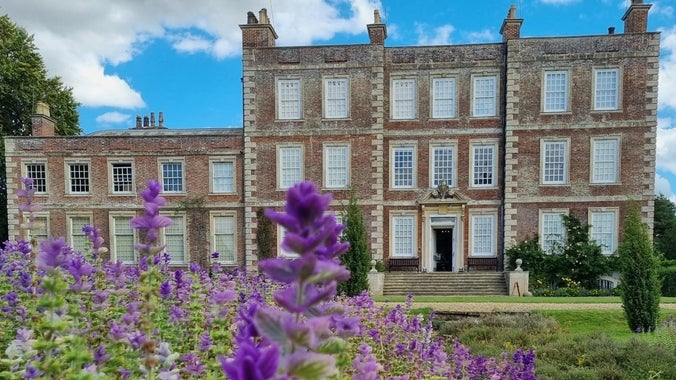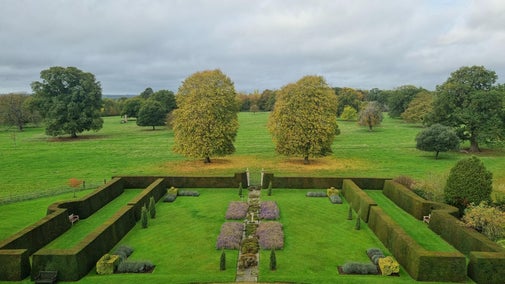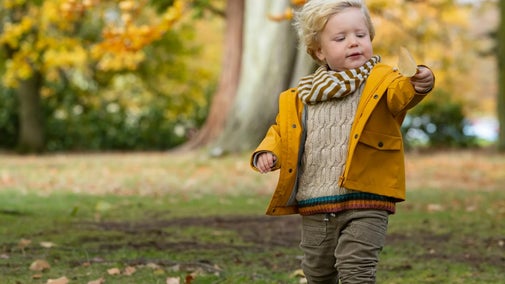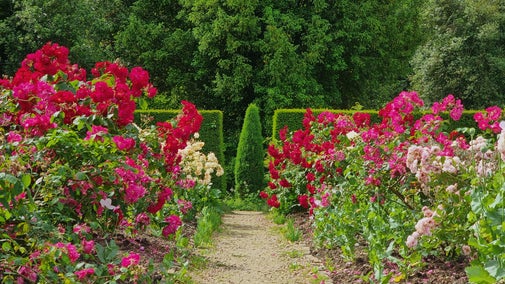Gunby Estate, Hall and Gardens
Nottinghamshire & LincolnshireA homely country house dated 1700 set in Victorian walled gardens at the foot of the Lincolnshire Wolds
Gunby, Spilsby, Lincolnshire, PE23 5SS

Important notice
Opening times for 2 January 2026
Asset Opening time Hall Closed Car Park 10:00 - 15:00 Garden 10:00 - 15:00 Parkland 10:00 - 15:00 Tea-room 10:00 - 15:00 MTWTFSS293031123456789101112131415161718192021222324252627282930311OpenPartially openClosedGardens Only - Admission from 01/03/2026
Ticket type With Gift Aid Without Gift Aid Adult (18+) £7.70 £7.00 Child (5-17) under 5s free £3.90 £3.50 Family (2 Adults and up to 3 children) £19.30 £17.50 Family (One Adult) £11.60 £10.50 House and Garden - Admission from 01/03/2026
Ticket type With Gift Aid Without Gift Aid Adult (18+) £13.20 £12.00 Child (5-17) under 5s free £6.60 £6.00 Family (2 Adults and up to 3 children) £33.00 £30.00 Family (One Adult) £19.80 £18.00 Become a member and discover more than 500 places
- Bookshop
There is a Second-hand bookshop in the courtyard.
- Car park
There is a 500 metre drive from the car park to the property entrance. There is a drop-off point for those who need it close to the entrance. There is a cycle rack located next to our visitor welcome building.
- Cycle parking
Cycle parking is located outside visitor reception. Ask at visitor reception if you want to borrow a lock.
- Dogs allowed
Well-behaved dogs welcome on short leads in the gardens and parkland.
- Licensed for civil weddings
- Tea-room
There is a tea-room in the courtyard.
- Toilet
There are toilets available in the courtyard.
The gardens include gravel paths and some uneven ground, with steps leading into the house. Mobility scooters and a wheelchair are available for outdoor use, with walkers and an indoor wheelchair available inside. It’s a 500-metre walk from the car park to the courtyard, but a drop-off point and closer parking can be arranged on request.
- Accessible route and/or map
- Accessible toilet
- Braille (guide or menu)
- Designated parking
- Drop-off point
- Induction loop
A portable induction loop is available for house tours on request.
- Level access to food outlet
- Narrow corridors
Please be aware there are narrow corridors In the house.
- Seating available
- Wheelchairs available
- By road
- On A158 off Gunby roundabout between Spilsby and Skegness. Signposted from A158. 13 miles east of HorncastleParking: Free, 500 yards from entranceSat Nav: PE23 5SS - please note that our entrance is an exit off the roundabout and not slightly beyond or before as some SatNav systems suggest.
- On foot
Get off the bus a few stops early at either Candlesbury Royal Oak Pub or Burgh Old Signal Box. From here, it'll take approximately 25 minutes to walk to Gunby.
Plan your journey on foot at Good Journey
- By train
There are direct trains to Skegness from: Boston (35 mins), Sleaford (60 mins), Grantham (85 mins) and Nottingham (2 hrs) with East Midlands.
There are direct trains Lincoln from: Gainsborough (25 mins), Newark (30 mins), Barnetby (35 mins), Doncaster (45 mins), Grimsby (55 mins), Sheffield (75 mins), Peterborough (80 mins) and Leicester (105 mins). Carefully follow the bus 56 Interconnect instructions. The bus station is beside the train station.
Plan your journey by train at Good Journey
- By bus
By Bus from Lincoln and Skegness Bus 56 passes the entrance, but it is a request stop. Hop off at the layby at Gunby roundabout, 530 yards from the entrance.
By Bus from Mablethorpe Bus 96A runs a few times per day (none on Sundays). Buses leave from Mablethorpe (35 mins), Sutton on Sea (30 mins) and Alford (15 mins). Buses run from Spilsby (10 mins) in the other direction. Jump off at Gunby roundabout.
Plan your journey by bus at Good Journey
- Cycling
- Cycle parking is located next to the visitor reception building in the car park. Please ask if you'd like to use the tyre pump or need a puncture repair kit. Gunby Estate, Hall and Gardens sits at the foot of the Lincolnshire Wolds on the A158 off the Gunby roundabout (Skegness 7.1 miles). Journey to Spilsby (5.5 miles away) Wainfleet All Saints (7.6 miles away) or Alford (9.0 miles away). Spilsby has been a market town since 1302 and was home to the Arctic explorer, Sir John Franklin. Born in 1786, he is credited with discovering the Northwest Passage. Plan your route to Spilsby or Wainfleet by using the cycle streets journey planner via the by bicycle link below (This journey planner uses OpenStreetMap data which is generally excellent by accuracy, but cannot be guaranteed. If you come to a footpath or other cycle-prohibited track, please do not ride on it). Local cycle and tandem hire is available from Wainfleet All Saints. Please view this website for details https://www.tandemjourneys.co.uk/
- Car-free
We hold the Good Journey Mark for welcoming car-free visitors. Travel a greener way and enjoy a free hot drink when arriving by train, bus or bike, with a valid train or bus ticket or bike helmet.
Plan your car-free journey to Gunby at Good Journey
Planning your visit
Events at Gunby Hall and Garden
Join one of our autumn walks and soak up the season’s beauty while we prepare exciting events for the year ahead.

Planning your visit to Gunby Hall and Gardens
Plan your visit to Gunby Estate and Gardens in Lincolnshire. There is no need to pre-book your visit at the moment.

Visiting Gunby with your dog
With over 1,500 acres of grounds, Gunby is the perfect place to bring your dog. Find out all you need to know about making your visit an enjoyable one. Gunby is a two pawprint rated place.

Group visits to Gunby
Find out more about booking your group visit to Gunby and the information you need to help plan your trip.

Map of Gunby Hall and Gardens
Take a look at the map of Gunby Estate, Hall and Gardens to help plan your visit.
Venue hire
Tie the knot with a wedding at Gunby...
Weddings at Gunby
From a heartfelt ceremony in the music room to garden photographs bathed in natural beauty, and a sparkling champagne reception in the Entrance Hall—Gunby offers a truly enchanting setting for your special day
Highlights
House
Gunby Hall is a characterful country home, built in 1700 for the Massingberd family, who lived there for over 250 years - leaving behind a rich legacy of stories, charm, and timeless appeal.
Gardens
Wander through eight acres of Victorian walled gardens, where a thriving kitchen garden, pockets of wildflowers, and vibrant borders burst into colour with the changing seasons.
Estate
Explore 1,500 acres of peaceful countryside, part of a traditional lowland farming estate where nature flourishes. Meandering permissive paths invite you to enjoy gentle, scenic walks through this thriving landscape.
Tea-room
Cosy tea-room located in the former laundry building with seating in the courtyard, serving sandwiches, snacks, hot/cold drinks and sweet treats.
Second-hand Bookshop
Tucked away in the former joiners’ workshop, our well-stocked second-hand bookshop is full of quality reads waiting to be discovered - just a short stroll from the courtyard.
Gallery
Tucked among the gardens, the Orchard Gallery - once a squash court - now offers a light-filled, characterful space for a changing programme of art exhibitions.
Things to see and do
Family-friendly things to do at Gunby Estate, Hall and Gardens
Make memories together at Gunby. Step inside the house to uncover its fascinating stories, wander through the gardens on your own little adventure, and take time to pause in the tea-room.

Explore Gunby Hall
Explore Gunby Hall, which was home to the Massingberd family for over 250 years. The house features intimate living spaces filled with notable objects, artistic works, and homely décor.

Explore the Gunby gardens
Discover eight acres of different garden ‘rooms’ with many different colours and textures to enjoy. Throughout each season there is something different to see.

Explore the Gunby estate
Find out more about the 1,500 acres of the Gunby Estate. Take a walk to discover an ice house pond, remains of a lost village and find evidence of a demolished medieval moated manor.

Top trails
Gunby Hall to Bratoft Manor walk
This linear trail takes in the historical lumps and bumps of the former Medieval village of Gunby.

Monksthorpe Chapel walk
Explore old churches and Monksthorpe Chapel on this scenic walk around Gunby's estate, as well as plentiful birdlife and a disused railway line.

Gunby ice house pond walk
Explore the wider estate and see what wildlife you can spot on this scenic walk to the renovated ice house pond at Gunby.

Places to stay

Gunby Old Rectory
A classic Georgian rectory house with a fine regency-style interior to match.

Orchard Cottage
Explore Gunby Hall and Gardens when you stay in this estate cottage set within its parklands.

Whitegates Cottage
A gorgeous traditional thatched cottage on the Gunby estate with walks all around.
Upcoming events
Guided Walk from Gunby to Bratoft Manor
Stride out and join us on a 3-mile walk to Bratoft Manor (the former home of the Massingberd family). This walk will take you to the wider estate and pass through the old medieval village of Gunby.
Blue Monday Social Walk
Beat the January Blues at Gunby! Join us on Blue Monday – Monday 19 January 2026 for a refreshing social walk through the gardens to the Ice House Pond. The walk will be led by one of our knowledgeable garden tour volunteers.
Snowdrop and Cake Guided Walks
Join us for 'Cake and Snowdrop Walks Week' from 14 to 20 February. Enjoy a nice slice of cake and a hot drink (included in the price). Includes entrance to the garden. House entry is £5 for non members (payable on the day).
National Lottery Open Week
As a thank you to National Lottery players for supporting our conservation work, we're offering free entry during National Lottery Open Week! Bring your lottery ticket or scratch card and explore Gunby Estate, Hall and Gardens .
Easter Adventure's at Gunby Estate, Hall and Gardens
This spring, treat the whole family to a world of adventure at Gunby Estate, Hall and Gardens on an Easter trail. The trail may be bought on the day.
'Springtime Wonderland' an exhibition by Laura Andrew
Gunby Hall warmly welcomes Laura Andrew with her new exhibition 'Springtime Wonderland'.
Gunby Local Makers Market
Join us on Good Friday for our annual 'Local Makers Market Day'. The day celebrates all the fine produce and items created by local trade and craft sellers.
About Gunby Estate, Hall and Gardens
Nestled below the Lincolnshire wolds, this sweeping estate secludes a charming country house flanked by Victorian walled gardens.
Built in 1700 for the quietly influential Massingberd family, the house features intimate rooms with homely décor and artistic works by notable names.
Meander gardens with striking seasonal colour, creative borders, and picture-perfect lawns. Estate walks offer refreshing scenic views of the flatlands.
History
History of Gunby Estate, Hall and Gardens
From the remnants of a medieval village to a charming red-brick house with a Victorian flourish, Gunby was home to the Massingberd family for over 250 years—though the estate’s story stretches back even further.

Art and collections
Gunby Hall's objects and collections
Explore the objects and works of art we care for at Gunby Hall on the National Trust Collections website.

Our work
Our response to National Grid's proposal to build a new transmission line from Grimsby to Walpole
The National Trust has shared concerns about National Grid's plans to build a new high-voltage electricty transmission line between Grimsby and Walpole.

Our work at Gunby Hall and Gardens
Find out more about the work being done to protect and restore Gunby, inside and out.

Support us
Volunteer opportunities at Gunby Hall and Gardens
Find out more about volunteering opportunities at Gunby and how you can join the team to play your part in looking after this homely country house and estate.
